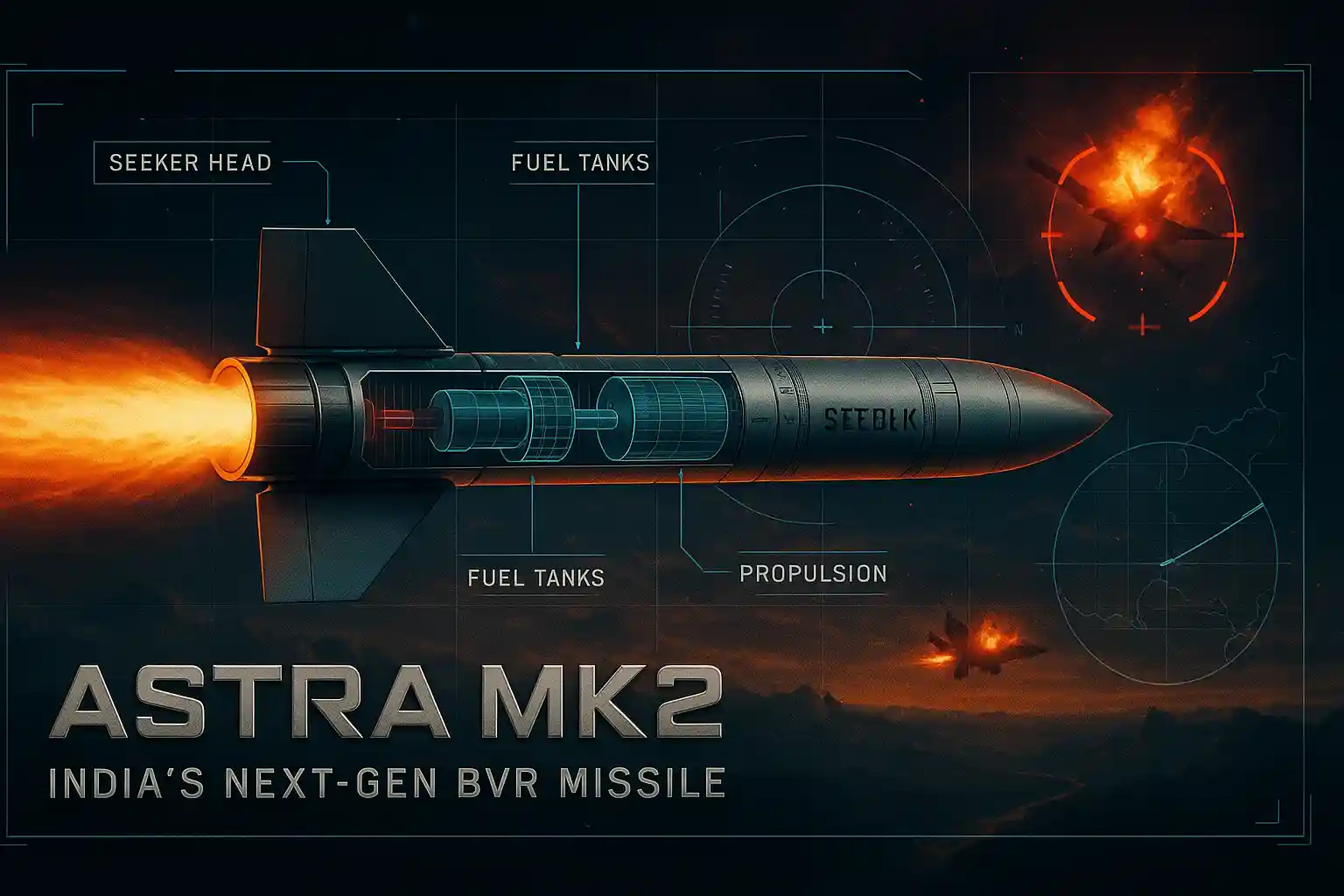What if your enemy never even knew you were there until it was too late? That is the advantage I believe, the Astra Mk2 Beyond Visual Range Air-to-Air Missile (BVRAAM) offers. In today’s fast-changing world of aerial warfare, victory depends not just on speed or stealth but on range, accuracy, and the ability to strike before detection. The Astra Mk-II is India’s decisive leap in that direction.
Developed by the Defence Research and Development Organisation (DRDO), the Astra Mk-II blends precision, extended reach, and indigenous innovation, giving the Indian Air Force (IAF) a formidable edge against top global powers. To me, it is more than a missile; it is a clear statement of India’s commitment to defence self-reliance.
As of 13th August 2025, with Tejas Mk-1A integration set to begin in late 2025 and Su-30MKI user trials about to commence, the Astra Mk-II is moving rapidly from testing to frontline deployment. It is poised to redefine India’s BVR combat capabilities in a complex regional security environment.
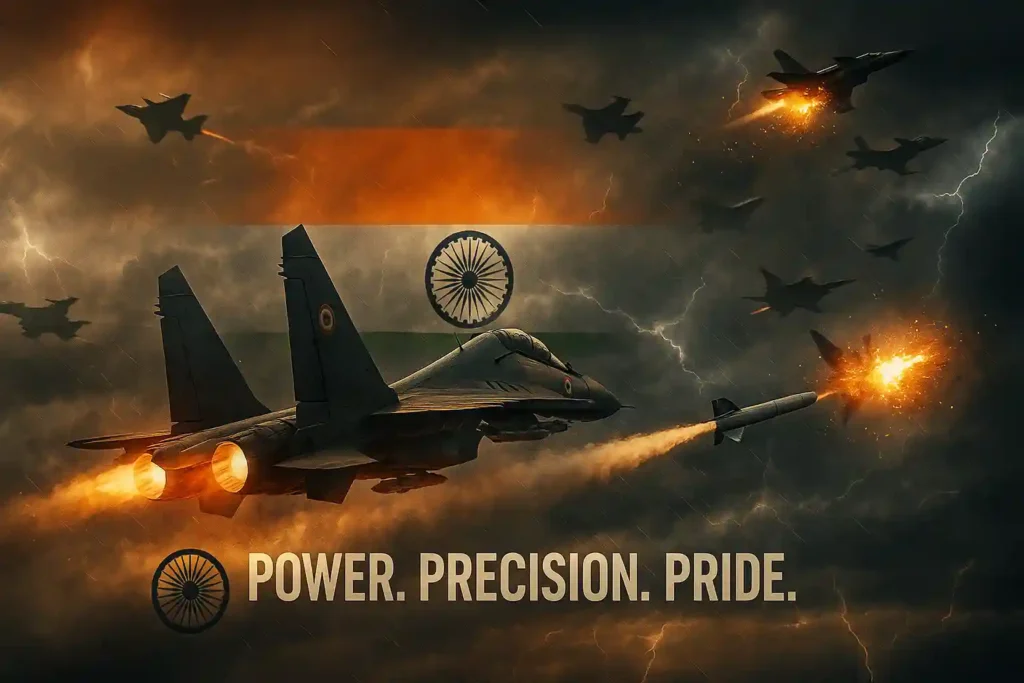
What is Astra Mk-II? A Next-Generation Indian BVR Missile
The Astra Mk-II is an upgraded Beyond Visual Range Air-to-Air Missile designed to neutralise enemy aircraft far beyond visual sight. Building on the success of the Astra Mk-I, it extends the effective range from 110 km to 160–200 km, thanks to advanced propulsion, guidance, and seeker technologies.

Its design gives Indian fighter jets the first-shot advantage, allowing them to engage hostile aircraft without entering close-range dogfights. This capability not only enhances India’s air superiority but also reinforces deterrence along both western and eastern fronts.
From my perspective, the Astra Mk-II is a cornerstone of India’s Make in India defence initiative, ensuring that our skies are protected by home-grown technology.
Technical Specifications and Features

- Range: 160–200 km, depending on launch conditions
- Speed: Capable of exceeding Mach 4
- Propulsion: Dual-pulse solid rocket motor for longer burn time and better end-game agility
- Guidance System: Mid-course guidance via datalink with terminal active radar homing
- Seeker: High-resolution active radar seeker for precision targeting
- ECCM Capabilities: Advanced electronic counter-countermeasures to overcome enemy jamming
- Warhead: High-explosive fragmentation with radio proximity fuse
Astra Mk2 vs Astra Mk1: What’s Improved?

- Extended Range: Nearly double the reach
- Dual-Pulse Motor: Better energy efficiency and end-game agility
- Advanced Seeker: Increased kill probability under evasive manoeuvres
- Expanded Platform Integration: Su-30MKI, Tejas Mk1A, future AMCA and possibly Rafale
- Reduced Launch Signature: Makes it harder to detect post-launch
Astra Mk2 is a generation ahead, designed to outperform both older Indian systems and imported alternatives.
Note: The Astra Mk-II features an indigenous RF seeker, representing a breakthrough in India’s missile technology. You can explore its development and capabilities in our dedicated article on the Astra BVRAAM Indigenous RF Seeker.
Why Astra Mk-II is Strategically Important for India
Modern air combat is dominated by BVR engagements. A missile with longer reach and higher accuracy can decide the outcome before the enemy even has a chance to react.
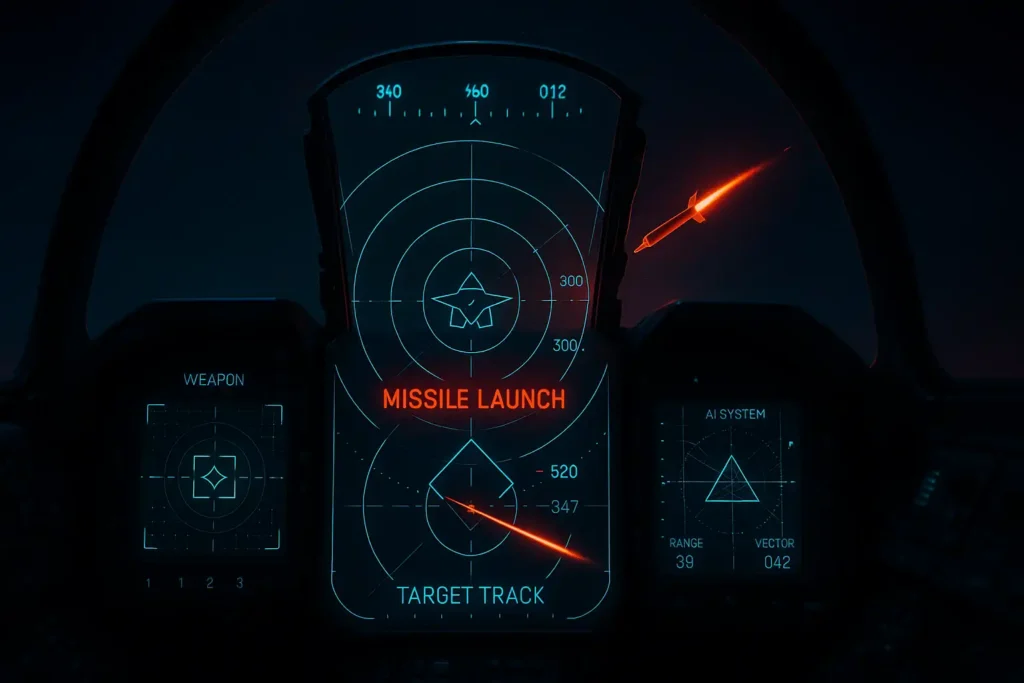
From my viewpoint, the Astra Mk-II provides:
- First-shot advantage: Engage targets before being detected
- Pilot safety: Avoid risky close-range manoeuvres
- Airspace control: Threaten high-value enemy assets such as AWACS and refuelling aircraft
- Deterrence: Send a clear signal to adversaries that India has cutting-edge BVR capabilities
Global Context: How Astra Mk-II Compares to Rivals
How does Astra Mk2 compare globally?
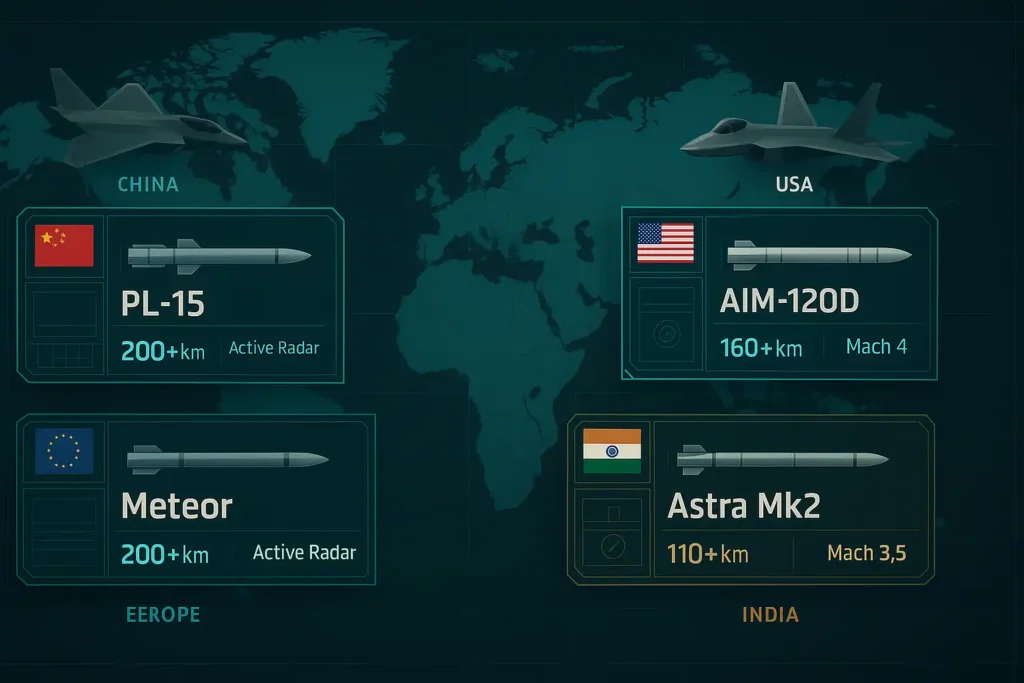
| Missile | Country | Range | Notable Features |
|---|---|---|---|
| Astra Mk-II | India | 160–200 km | Dual-pulse motor, active radar seeker, cost-effective |
| PL-15 | China | 200–250 km (claimed) | AESA seeker, longer claimed range |
| AIM-120D | USA | 180+ km | Combat-proven, advanced ECCM |
| Meteor | Europe | 200+ km | Ramjet propulsion, high no-escape zone |
While the PL-15 and Meteor may boast higher ranges on paper, the Astra Mk-II matches their effectiveness in practical scenarios at a significantly lower cost, with the added benefit of indigenous production and export flexibility.
Deployment, Testing, and IAF Induction Timeline
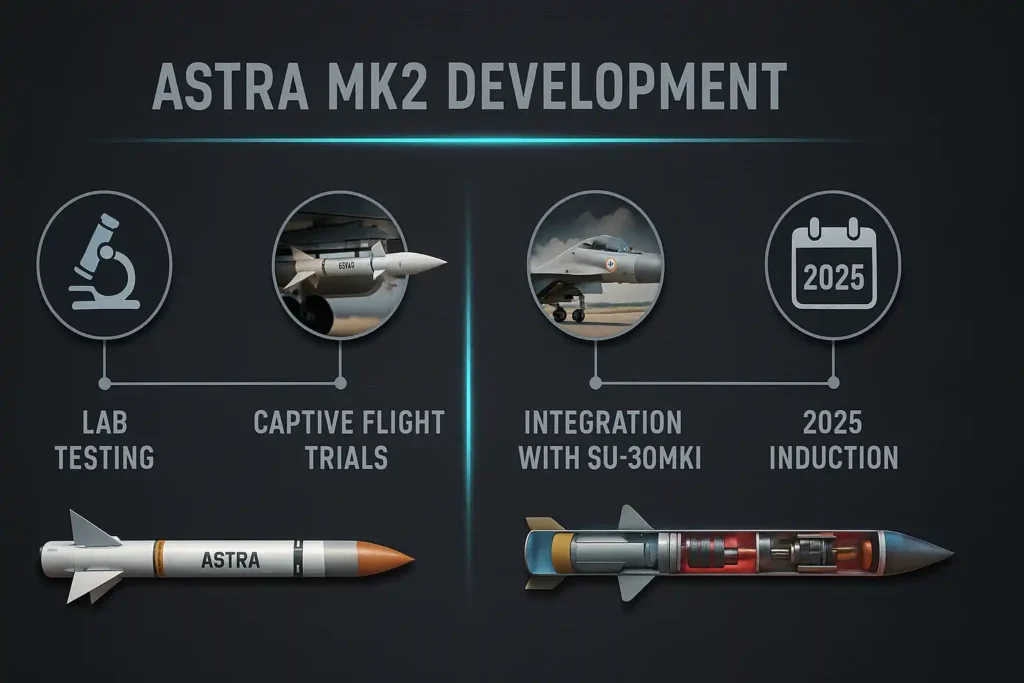
- 2021–2022: Ground tests validate propulsion and seeker performance
- 2023: Captive flight trials on Su-30MKI platforms
- 2024: System refinements, seeker calibration, and ECCM tests
- 2025: Induction phase begins for front-line IAF squadrons
This timeline reflects India’s steady push to bring the Astra Mk-II from development to operational readiness in under a decade.
Upcoming Integrations: Tejas Mk-1A and Su-30MKI
Tejas Mk-1A Integration – Late 2025
As of 13th August 2025, I believe the Astra Mk-II BVRAAM is entering a pivotal stage, with HAL set to integrate it on the Tejas Mk-1A by late 2025, involving structural fitment, mission computer synchronisation, and live-fire trials at varied altitudes and speeds. This will give Tejas an indigenous 160+ km strike range, reducing reliance on imported missiles like the R-77 and Derby.
Su-30MKI User Trials – Imminent
The Indian Air Force will soon begin user trials of the Astra Mk-II on the Su-30MKI, testing its seeker, propulsion, data-link, and proximity fuse against aerial targets in realistic combat scenarios. With its powerful radar and long endurance, the Su-30MKI is expected to be the first operational platform for the missile, marking a major step in India’s ability to field world-class BVR weapons designed and built at home.
Future Scope: Astra Mk-III and India’s Indigenous Missile Ecosystem
The Astra programme is structured in tiers:

The Astra programme follows a tiered approach:
- Mk-I: Short-to-medium range BVR, already operational
- Mk-II: Medium-long range (160–200 km)
- Mk-III (Gandiva): SFDR-based missile with over 300 km range in development
Bharat Dynamics Limited (BDL) and private firms such as VEM Technologies are scaling up production, while India explores export opportunities in Southeast Asia, the Middle East, and Africa.
Challenges Before Full Operationalisation
Despite the promise, some technical challenges remain:

- Seeker tuning in cloudy, coastal, and desert conditions
- Altitude performance optimisation for both low and high-level engagements
- ECM resilience testing against advanced jamming
DRDO is actively working on resolving these through extensive testing and iterative refinements.
Conclusion: More Than Just an Upgrade
To me, the Astra Mk-II is far more than a successor to the Mk-I; it is a strategic leap that empowers India to shape the air combat arena on its terms. With deeper engagement zones, smarter tracking, and indigenous production, it secures the skies while strengthening national pride.
By 2030, if integration across all frontline fighters is achieved, the Astra family could become the backbone of India’s BVR capability, a true game-changer in South Asia’s aerial power balance.
FAQs About Astra Mk-II
Q1: What is the Astra Mk-II missile?
Astra Mk-II is India’s second-generation BVRAAM developed by DRDO, with a range of 160–200 km and active radar guidance.
Q2: How is Astra Mk-II different from Astra Mk-I?
It has nearly double the range, improved seeker accuracy, dual-pulse propulsion, and expanded platform compatibility.
Q3: What is the range of Astra Mk-II?
It can engage targets between 160 and 200 km, depending on altitude and flight profile.
Q4: Which aircraft will carry Astra Mk-II?
Initially, the Su-30MKI, followed by Tejas Mk-1A, AMCA, and possibly Rafale.
Q5: When will Astra Mk-II enter IAF service?
It is expected to enter service in 2025 after successful trials on Su-30MKI.
